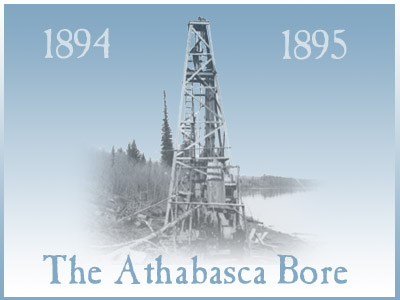
![]()
Three early attempts to tap the oil reserves of Alberta were made by the Geographical Survey of Canada in the 1890s, two on the Athabasca River near Athabasca Landing and Pelican Rapids, and one on the North Saskatchewan River near Victoria mission. It was believed at the time that there were vast reserves of oil around these areas due to the oil sands farther north. The first well was sunk about two miles upstream from the Landing. By September of 1894, the bore had been sunk to 400 feet where a large field of natural gas was discovered. By October of that same year it was down over 1000 feet, which was where the drilling tools hit quicksand and work was suspended for the winter. Work began again in the spring and the well cleared and sunk to some 1770 feet before being abandoned. Since the drillers kept using successively smaller casings, they could drill no further. (Memorandum on Experimental Boring in Alberta, NWT. Athabasca Landing, May 14, 1895)
The drillers then decided to move to Pelican Portage, near Pelican Rapids on the Athabasca River. “The well was spudded in the early summer of 1897, and before winter of that year had reached a depth of 820 feet, where a huge field of natural gas was struck.” According to reports, the well
blew every drop of water out of the bore, the roar of the gas could be heard for three miles or more. Soon it had completely dried the hole, and was blowing a cloud of dust fifty feet into the air. Small nodules of iron-pyrites, about the size of a walnut, were blown out of the hole with incredible velocity, they came out like bullets from a rifle. [The workers] could not see them going, but could hear them crack against the top of the derrick. It was impossible to do anything with the bore that day, so they were forced to let it stand just as it was. There was danger that the men would be killed if struck by these missiles.” (Court 1973, 11)
It was soon decided that drilling would be suspended for the winter “in the hope that the gas would blow off.” Work began again in 1898, but no sooner was the hole cleaned out than the “gas increased in power and blew great clouds of sand and gravel higher than the derrick.” (Court 1973, 11) The well site and equipment were abandoned and the gas was
left to blow wild, which it did for some twenty-one years, before being capped by S.E. Slipper. As the gas was lit from time to time the area proved to be a favorite winter campsite for the local Indians, and was the subject of great wonder. (Court 1973, 11)
Home | Hudson's Bay Company Post | The Landing Trail | Society, Gender, and Race | Transportation Hub | Boatbuilding | To the Klondike | The Commercial Boom | Amber Valley | The Athabasca Bore | Agriculture and Settlement | Then and Now